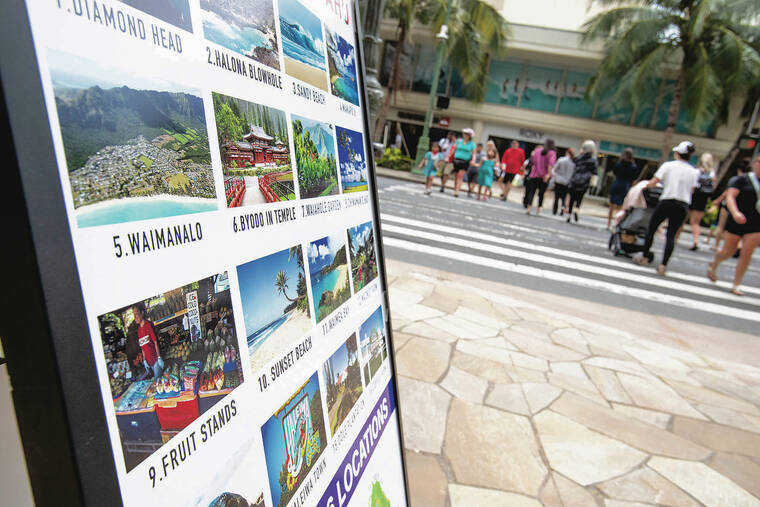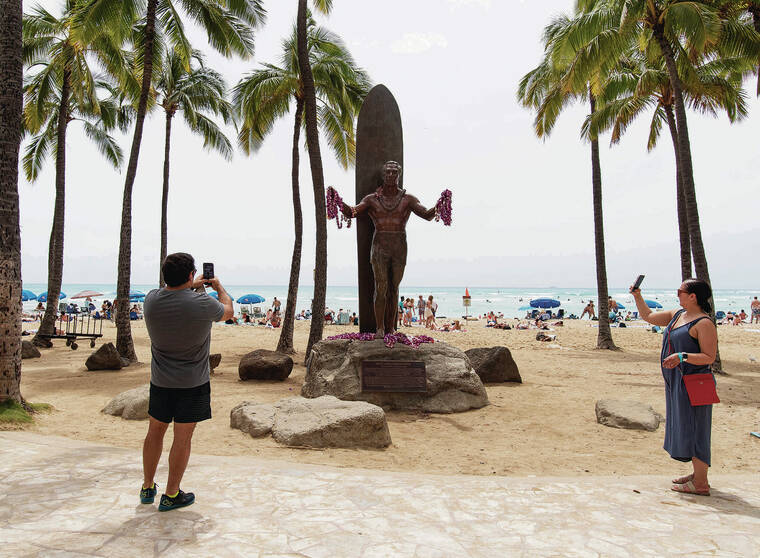Golden Week traditionally spurs peak spring travel demand from visitors from Japan to Hawaii because the period, which includes four national holidays, means the longest vacation of the year for many workers there.
This year’s Golden Week, which runs April 29-May 5, is expected to be the best one since the pandemic started in 2020. However, it isn’t shaping up to be that “golden,” and a more significant pickup of Japanese arrivals to Hawaii is not forecast to occur until summer or beyond.
Eric Takahata, managing director of Hawaii Tourism Japan, a contractor for the Hawaii Tourism Authority, said Golden Week in Hawaii was virtually nonexistent in 2020 and 2021 due to fear of COVID-19 and travel restrictions in Hawaii and Japan. Golden Week in 2022 brought the return of package tours from Japan, which had been absent for the first two years of the pandemic, but traffic wasn’t robust.
Takahata said most travelers from Japan will take May 1 and 2 off so that they can capitalize on all of the Golden Week holidays. Takahata said demand for this year’s Golden Week will be stronger than in 2022, but that air seats aren’t picking up by much. Seats for March still are down 56% from 2019, while they are down 52% in April and 48% in May.
Yuko Akiba, director of digital marketing for PacRim Marketing Group Inc., said, “We have heard to anticipate more recovery in the summer rather than Golden Week.”
The changing psyche of the Japanese traveler is among the reasons; another is pricing. Akiba said Golden Week fares range from about $1,800 to $3,000, including the airline fuel surcharge, so it’s definitely higher than pre-COVID-19, when it was around $1,500. She said as of mid-March seats were still available for the Golden Week travel period on Japan Airlines, All Nippon Airways and Hawaiian Airlines, adding that “before COVID there wouldn’t have been many seats left by now.”
Tara Shimooka, spokesperson for Hawaiian Airlines, confirmed that “demand from Japan remains weak overall.”
Shimooka said that “Golden Week load factors and fares are modestly higher” and that the carrier is “excited to be resuming service between Honolulu and Fukuoka on April 28, in time for Golden Week travelers.”
But she added that “while we remain confident that with time the long-standing affinity of Japanese travelers for Hawaii vacations will manifest, we also need to be pragmatic in putting capacity elsewhere if recovery remains slow.”
Akiba said ANA, JAL and Hawaiian have all run spring promotions for outside of Golden Week, which “probably means that they are struggling to fill up seats.”
Shimooka said Hawaiian Airlines, in partnership with Outrigger Resorts, recently gave away 500 free trips from Japan to Hawaii as a way of stimulating interest, and “we were encouraged by the robust interest in that promotion.”
“It’s clear that Hawaii remains an aspirational destination for Japanese consumers, if we can overcome perceived barriers to travel,” she said.
Regaining the Japan visitor market, which historically has been Hawaii’s top international market, has been a disappointing yet critical progression.
The state Department of Business, Economic Development and Tourism reported Thursday that February saw just 26,650 arrivals from Japan. While that was up significantly from the 2,181 visitors from Japan who came to Hawaii in February 2022, it was down 77.9% from the 120,653 who visited in February 2019.
Takahata said Japanese arrivals to Hawaii are anticipated to reach just 25% to 30% of the 2019 level during the first two quarters. He said 2023 is forecast to recover to 50% of 2019, but reaching that will require more rapid acceleration in the second half of the year.
In the spring of 2022, the Japan Association of Travel Agents visited Hawaii and forecast that by the end of 2022, Japanese visitors would have recovered to 40% of the pre-pandemic level and by this year would have beaten 2019 levels. So why did that forecast prove overly bullish?
The economic challenges due to high fuel surcharges and an unfavorable yen-to-dollar exchange rate have only compounded the overall impact of Hawaii’s higher travel prices. Shimooka said, “While yen/dollar exchange rates are clearly not favorable, the more significant issue we hear from consumers in Japan is the much higher all-in cost of a vacation, driven particularly by accommodations, in Hawaii.”
Dave Erdman, founder, president and CEO of PacRim, also touched on other issues, such as the difficulty for Japanese film crews to get appropriate visas for production and to bring celebrities and talent to Hawaii.
Erdman said a decline in school trips during the three years of the pandemic has meant youths are not traveling, experiencing other cultures or applying for passports. He said the slowdown in the Meetings, Incentive, Convention and Events group business from Japan also has been a concern.
COVID-19 has long been a psychological barrier to travel in Japan, where the government in 2022 had to implement a domestic stimulus program to get people to start traveling again, even locally. Another big change took place March 13 when the Japanese government dropped its mask request, now leaving the decision on masking largely up to individuals. Dropping the mask-wearing request is one of the last steps Japan’s government is taking in easing COVID-19 rules in public places as it tries to expand business and other activity.
It’s thought that dropping the mask request, along with the expectation that Japan will downgrade COVID-19’s classification status to flu-like right after the Golden Week holidays, will help stimulate demand for longer-haul travel, which has yet to come back from the serious hit that it took in the earlier part of the pandemic. Further loosening of U.S. entry requirements also could make travel more attractive, especially for travelers who have not gotten COVID-19 vaccinations.
Akiba said, “The U.S. is supposed to loosen up border rules on May 11 (after Golden Week), and while we’re not sure if they will remove the two-time vaccination policy to fly into the U.S., if they do remove that policy, that may help give the impression that it’s safer to travel and will allow unvaccinated travelers to consider returning to Hawaii.”
Shimooka said Hawaiian Airlines has seen gradual growth in bookings and interest from Japan, but it is not clear the changes in COVID-19 measures there have driven a major change in consumer behavior.
“There remains a great deal of concern among Japanese consumers about the safety and appropriateness of international travel that will need to be overcome before visitors return in large numbers,” she said.
Erdman said that just a day after Japan removed the mask request, “we still saw most Japanese still wearing masks, partially because of prevention of ongoing COVID and worry over COVID, out of respect for others, and in some cases, continued requests or mandatory rules related to mask wearing in hospitals, at events, and in government offices. The government also recommends mask use when traveling on packed trains and buses, though some transportation companies have announced they will let passengers decide.”
Cherry blossom and hay fever season also have made it difficult to discern whether Japan’s attitude toward masking is any different, he said.
Erdman said it’s far easier to determine just how important Japan’s recovery is for Hawaii tourism, especially at a time when an anticipated softening of the U.S. and global economy has made diversification of the traveler mix even more important.
“Our retail sector has been fortunate over the years to have Japanese travelers as high spenders across all segments of retailers,” Erdman said. These range from ABC Stores to omiyage-focused retailers that sell items visitors like to take home as gifts, such as candy and cookie makers, clothing and product manufacturers, and luxury global brands. “The return of Japanese travelers might not seem critical to these businesses because they are enjoying strong westbound business at this point, but the customer purchase behavior is different,” he said. Additional spending by Japanese visitors “will help lift all retailers to positive performance and contribute to a more stable Hawaii economy.”
Sayuri Kimura, PacRim’s executive vice president, said many small businesses in Hawaii, and in particular on Oahu and Hawaii island, have had to pivot and adapt to having fewer Japanese travelers.
”Hotels that have had high-value Japanese visitors have had to diversify during the pandemic, and currently seek new types of travelers. Perhaps that seems OK, but just trying to replace Japanese travelers is not a solution,” she said. “The Japanese travelers are culturally mindful travelers, high spenders who most likely have the highest ‘life-time value’ as an overall customer as heavy, consistent repeaters, with many traveling here 10 or more times. These travelers are critical to our visitor industry, not just for now, but for the long-term future.”
———
The Associated Press contributed to this story.






